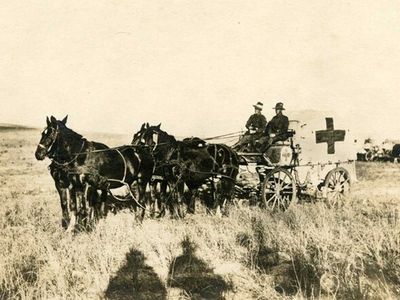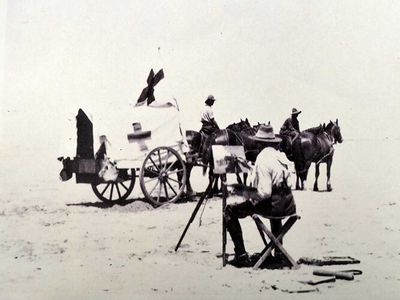“Major Avery, among many other Old Boys, holds a special place on the TGS Old Boys’ Wall of Achievement for his role in inventing the “Rapid Transit Ambulance” that was a key part of the Australian Light Horse Brigade.”

On ANZAC Day, we come together to reflect on the importance of service and sacrifice.
Toowoomba Grammar School would like to acknowledge our admiration for the loyalty, service and bravery exhibited by TGS Old Boys who so valiantly served. We are all the beneficiaries of their sacrifice, and their selfless actions continue to inspire a spirit of service amongst our current students.
Today we focus on the contribution of one TGS Old Boy who made a significant contribution to World War I. Here is some of the incredible story of Major Avery, DSO and if you visit the School Museum and Archives you can see a display in his honour.
Much of this history has been captured through countless hours of dedication and devotion by current TGS museum volunteer and former TGS staff member, Mrs Ann Hallam who managed the School’s Cadet Unit from 2006-2019.
Major Avery DSO, inventor of the WWI “Rapid Transit Galloping Ambulance”
Distinguished TGS Old Boy, Leonard Grimes (1880-1885) was born in Queensland in 1869 and died in 1953. Grimes attended the School in the days of Sir Harry Chauvel and Sir Littleton Groom and while at TGS was known as Leonard Avery Grimes.
After his School days he went on to Wadham College, Oxford, where he graduated with a medicine degree. He later changed his name to Conrad Avery and after some years as a hospital physician and surgeon, Avery enlisted with the British Army and joined the Suffolk Imperial Yeomanry. He was later promoted to Major and joined the Royal Army Medical Corps. During World War I he was enlisted with the Royal Westminster Dragoons and served in Palestine, Egypt and Syria.
Major Avery, among many other Old Boys, holds a special place on the TGS Old Boys’ Wall of Achievement for his role in inventing the “Rapid Transit Ambulance” that was a key part of the Australian Light Horse Brigade.
Light Horse Field Ambulance
The Light Horse units were mounted infantry with efficient mobile medical support to the wounded and sick soldiers of an Australian Light Horse Brigade. The Field Ambulance ensured the removal of the wounded from the front line to the advanced dressing station where there were surgical and resting tents.
These sand carts had two wheels with tyres that were wide enough to stop the cart digging into soft sand and could carry two or three stretchers. In heavy sand four horses were necessary to pull the cart, and the cart had to be steered by a rider on one of the lead horses.

Australian Light Horseman
The 2nd Light Horse Field Ambulance was formed in Brisbane with much of the unit coming from Queensland.
More than 15 TGS Old Boys enlisted with the Second Light Horse Brigade, two of whom died at Gallipoli: Major Dugald Maxwell Lockwood Graham and Trooper Gordon Holmes Robertson.
During the World War I, George W. Lambert (1873-1930) served Australia as an Official War Artist attached to the ANZAC Mounted Division. He spent two terms in service, the first with the Light Horse in Palestine, and the second in Gallipoli and Egypt before his military contract discharge.
As a result of Lambert’s service during World War I, he was offered a variety of commissions to paint scenes from significant war time events, including an activity of the 2nd Australian Light Horse Field Ambulance, Walk (An Incident at Romani).
The Battle of Romani was the last ground attack on the Suez Canal at the beginning of the Sinai and Palestine Campaign. The battle was fought from 3 to 5 August 1916 near the Egyptian town of Romani.
The completed painting was to be given to the Queensland (National) Art Gallery by the Light Horse in memory of their fallen comrades.
The Rapid Transit Ambulance
Major Avery describes his vision for a new galloping ambulance, known as “The Rapid Transit Ambulance”.
This ambulance was designed with a view to filling the want of stretcher bearers with mounted troops. The endeavor has been to construct a light strong carriage easily adjustable to any mounted horse and capable of keeping up with cavalry through any sort of country. As will be seen from the accompanying illustration, the ambulance is a two-wheeled contrivance.
The body consists of a platform fixed to a crank axle by long springs between 46-in. wheels. This platform is 2 ft. 3 in. from the ground and is arranged to carry an ordinary service stretcher. The forepart consists of a pair of short shafts which are attached to the body by an arrangement of springs adapted to prevent the side-to-side motion caused by the action of the horse. The shafts reach as far forward as the saddle flaps, where they are held in position by a girth strap, breastplate, and belly-band.
The body is covered by a canvas hood. The weight is about 3 cwt. Length overall, 12 ft. Track, 4ft. 1 in. Surgical dressings, splints, water-bottle, &c., are carried. It is quite easy for the driver, having placed a wounded or helpless man in a stretcher, to transfer him from the ground to the platform of the carriage single-handed.
This ambulance has been on duty with the Suffolk, Sussex, Surrey and Middlesex Imperial Yeomanry during their respective training, and with the Wiltshire Yeomanry through the recent maneuvers. It is a very comfortable conveyance and has proved capable of negotiating with almost any country.
Walk (An Incident at Romani)
The incident to which Lambert’s painting refers occurred during the Battle of Romani on 4 August 1916. The 2nd Light Horse Field Ambulance had deployed two sand-carts to an exposed part of the line to retrieve some seriously wounded men. Upon its return journey the Field Ambulance envoy came under Turkish fire and its panicked horses started to bolt.
Tragedy was averted when the corporal signaled ‘Walk’ and galloped to the front of the party to steady the teams. After the horses had been calmed and resumed their pace, the enemy apparently recognised the Ambulance’s mission and averted their fire. As a result of their bravery and composure during the incident the corporal and drivers were awarded Military Medals.

To enable Lambert to make sketches of the event that was already three years in the past, it was re-enacted at Kantara, Egypt in 1919. Photographs were taken of Lambert at work sketching this re-enactment. The completed painting portrays the moment when the corporal signals ‘Walk’ whilst rushing to the front of the group to steady the bolting teams.
Remembrance Day
Remembrance Day marks the anniversary of the Armistice which ended the First World War, signed at 11:00am on 11 November 1918. We still remember those who have given their lives in conflict before and since, by taking a minute to stop, be silent and remember the war that was to end all wars.
Latest Blog
Honouring Tradition, Preparing for the Future
They will invariably be inspired by effective teaching and the satisfaction of personal achievement will always be motivating. At Toowoomba Grammar School, the power of high-quality instructional practices has resulted in the development of a strong academic culture that has endured for nearly 150 years. Preserving core principles provides stability and continuity. However, we must be open to continuously adapting our methods so that our students are well-prepared for the ever-changing world…
We See You - Mitchell Wilkes
That was the heart-wrenching diagnosis for Year 10 student, Mitchell Wilkes, right on Christmas in 2021. Mitchell’s mum noticed he wasn’t reading properly and had a gut feeling that there was something wrong with his eyesight. A trip to the optometrist revealed a thinning in the retina, and further tests showed that Mitchell had a genetic condition called Stargardt Disease, a juvenile macular degeneration illness that results in slow central vision loss.
Correcting our School's official record commemorating World War I and World War II
On the eve of our 150th year, we're calling on the School's alumni, parents, past parents and greater community to aid us in correcting the record of our involvement in two watershed geopolitical events of the 20th century. For the last four years Toowoomba Grammar School Museum Volunteers, Mrs Ann Hallam and Mrs Sue Palmer, have been updating the School records on Old Boys, staff and Trustees for the World War I and World War II theatres of war. Over the years several staff and volunteers have…
A Pioneering Woman of TGS
My late husband was a teacher, and our four children are all teachers, which we encouraged them to do because it is the best job in the world. It’s hard to believe I’ve been here for 36 years, working under four Headmasters: Mr Bill Dent, Mr Hugh Rose, Mr Peter Hauser and now Dr John Kinniburgh. I still drive into the School each day and smile, looking at the beautiful place it is — magnificent ovals, gracious trees and historically significant buildings. It is difficult to express the…
NZ Rugby Tour success, more than winning matches across the Ditch
The teams were undefeated and it was a trip the players will never forget. This tour was years in the making and heralds a new era of touring and hosting different rugby schools to give our players opportunities for growth as athletes and as people. Head of Sport - Rugby, Mr Lincoln Clapham, explained they selected 46 students to take part in the ten-day tour and began training last year. From Term 1 onwards, the squad trained twice weekly on the oval plus two and sometimes three gym sessions…
Aussie Teen Reading Habits Revealed
I was recently sent an article, summarising some research from Deakin University around the reading habits of teens in 2024. Some of it was, as the title suggests, surprising. Some was not. However, all of it was built around the importance of reading, and supporting our teens to read, which is something that every one of us should do. While we tend to see our teens as digital natives, recent research from Deakin University suggests that the average Aussie teen reader would rather flick through…
Now More Than Ever
The one-of-a-kind Indigenous artwork is emblazoned across the shirts for the First IV Tennis team, jerseys for the First XI Football team and First XV Rugby team and First V Basketball team's singlets. National Reconciliation Week is a significant date on the calendar for all Australians, running from Monday, 27 May to Monday, 3 June. The incorporation of this Indigenous design in our uniforms is a significant milestone for our School, especially for our 47 Aboriginal and Torres Strait…
It's a numbers game, making mathematics mainstream
Term 2 has been a busy one in the Mathematics department; from multiple year levels having extended assessment tasks to competitions run inside and outside the School. Using mathematical equations to recreate artwork The Year 11 Mathematical Methods students got a chance to be very creative with their assessment - using numbers to reproduce artwork. The boys visited the 2024 Grammar Art Show in Term 1 and were given the task to reproduce a chosen work using their knowledge of mathematical…
Bucolic beginnings, boarding and becoming a bowel surgeon
Coming from a cattle property near Injune I was in awe of the School’s ovals with lush, green grass and immaculate facilities. I found being able to throw yourself around and not risk skin cuts and grazes quite novel. Sharing the same field where many Old Boys and past heroes trotted was inspirational. I found the comradery among the boarders my most overwhelming memory. It was like having 60 brothers with similar interests all living under the same roof. There was always someone around to kick…